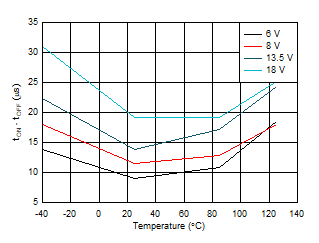SLVSE19B June 2019 – November 2021 TPS1HB50-Q1
PRODUCTION DATA
- 1 Features
- 2 Applications
- 3 Description
- 4 Revision History
- 5 Device Comparison Table
- 6 Pin Configuration and Functions
- 7 Specifications
- 8 Parameter Measurement Information
-
9 Detailed Description
- 9.1 Overview
- 9.2 Functional Block Diagram
- 9.3
Feature Description
- 9.3.1 Protection Mechanisms
- 9.3.2 Diagnostic Mechanisms
- 9.4 Device Functional Modes
- 10Application and Implementation
- 11Power Supply Recommendations
- 12Layout
- 13Device and Documentation Support
- 14Mechanical, Packaging, and Orderable Information
Package Options
Mechanical Data (Package|Pins)
- PWP|16
Thermal pad, mechanical data (Package|Pins)
- PWP|16
Orderable Information
7.8 Typical Characteristics
 Figure 7-1 Transient Thermal Impedance
Figure 7-1 Transient Thermal Impedance
| IOUT = 0 A | VEN = 5 V | VDIAG_EN = 5 V |
| RSNS = 1 kΩ | VSEL1 = 0 V |

| IOUT = 200 mA | VEN = 5 V | VDIAG_EN = 0 V |
| RSNS = 1 kΩ |

| ROUT = 6 Ω | VEN = 0 V to 5 V | VDIAG_EN = 0 V |
| RSNS = 1 kΩ | VBB = 13.5 V |

| ROUT = 6 Ω | VEN = 0 V to 5 V | VDIAG_EN = 0 V |
| RSNS = 1 kΩ | VBB = 13.5 V |

| ROUT = 6 Ω | VEN = 0 V to 5 V | VDIAG_EN = 0 V |
| RSNS = 1 kΩ | VBB = 13.5 V |

| ROUT = 6 Ω | VEN = 0 V to 5 V and 5 V to 0 V | VDIAG_EN = 0 V |
| RSNS = 1 kΩ | VBB = 13.5 V |

| VSEL = 0 V | VEN = 5 V | VDIAG_EN = 5 V |
| RSNS = 1 kΩ | TA = 25°C |

| VSEL = 0 V | VEN = 0 V | VDIAG_EN = 5 V |
| RSNS = 1 kΩ | VOUT Floating |

| VEN = 0 V to 3.3 V | VOUT = 13.5 V | VDIAG_EN = 0 V |
| ROUT = 1 kΩ | VBB = 13.5 V |

| VEN = 0.8 V | VOUT = 0 V | VDIAG_EN = 0 V |
| ROUT = 1 kΩ | VBB = 13.5 V |

| ROUT = 6 Ω | RSNS = 1 kΩ | VDIA_EN = 5 V |
| VSEL = 0 V |

| ROUT =13 Ω to 6 Ω | RSNS = 1 kΩ | VSEL = 0 V |
| IOUT = 1 A to 3 A | VBB = 13.5 V |

| LOUT = 5 µH to GND | RLIM = 5 kΩ | VSEL = 0 V |
| VEN = 0 V to 5 V | VDIAG_EN = 5 V | TA = 25°C |

| VBB = 13.5 V | TA = 25°C | LOUT = 5 mH |

| VOUT = 0 V | VEN = 0 V | VDIAG_EN = 0 V |

| IOUT = 0 A | VEN = 0 V | VDIAG_EN = 5 V |
| RSNS = 1 kΩ | VSEL1 = 0 V |

| IOUT = 200 mA | VEN = 5 V | VDIAG_EN = 0 V |
| RSNS = 1 kΩ |

| ROUT = 6 Ω | VEN = 5 V to 0 V | VDIAG_EN = 0 V |
| RSNS = 1 kΩ | VBB = 13.5 V |

| ROUT = 6 Ω | VEN = 5 V to 0 V | VDIAG_EN = 0 V |
| RSNS = 1 kΩ | VBB = 13.5 V |

| ROUT = 6 Ω | VEN = 5 V to 0 V | VDIAG_EN = 0 V |
| RSNS = 1 kΩ | VBB = 13.5 V |

| VSEL = 0 V | VEN = 5 V | VDIAG_EN = 5 V |
| RSNS = 1 kΩ | VBB = 13.5 V | |

| VSEL = 5 V | VEN = 0 V | VDIAG_EN = 5 V |
| RSNS = 1 kΩ |

| VEN = 3.3 V to 0 V | VOUT = 0 V | VDIAG_EN = 0 V |
| ROUT = 1 kΩ | VBB = 13.5 V |

| VEN = 0 V to 3.3 V and 3.3 V to 0 V | VOUT = 0 V | VDIAG_EN = 0 V |
| ROUT = 1 kΩ | VBB = 13.5 V |

| VEN = 5 V | VOUT = 13.5V V | VDIAG_EN = 0 V |
| ROUT = 1 kΩ | VBB = 13.5 V |

| ROUT = 6 Ω | RSNS = 1 kΩ | VDIA_EN = 5 V |
| VSEL = 0 V |

| VBB = 13.5 V | TA = 25°C | IOUT = 3 A |
| VEN = 0 V to 5 V |

| LOUT = 5 µH to GND | RLIM = 5 kΩ | VSEL = 0 V |
| VEN = 0 V to 5 V | VDIAG_EN = 5 V | TA = 25°C |